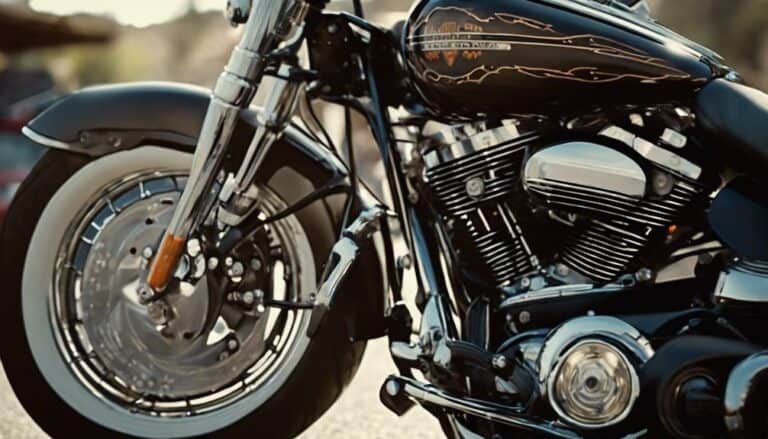Ever wondered what exactly the rake on a Harley Davidson is and why it matters?
Understanding this fundamental aspect of your bike's design could unlock a whole new level of comprehension about its performance and handling.
The rake angle influences how your motorcycle behaves on the road, affecting its stability, steering responsiveness, and overall riding experience.
Delving into the intricacies of rake on a Harley Davidson might just unveil a world of insights that could elevate your biking knowledge and appreciation.
Key Takeaways
- Rake on a Harley Davidson affects steering response and stability.
- Rake angle directly impacts handling characteristics.
- Rake influences bike's stability at high speeds.
- Rake customization alters stability and maneuverability.
Understanding Rake on a Harley
Understanding the rake angle on a Harley-Davidson is crucial for riders seeking to grasp how this fundamental design feature influences the bike's steering dynamics and overall performance. The rake angle, typically ranging from 26 to 34 degrees on Harley-Davidson motorcycles, plays a pivotal role in determining the bike's steering response and stability. This angle is formed by the steering head's tilt concerning an imaginary vertical line. Together with the front end's fork length, the rake angle affects the motorcycle's trail, which is the distance between the contact patch of the front tire and the point where the steering axis intersects the ground.
A larger rake angle contributes to enhanced straight-line stability, making it ideal for cruising at higher speeds. Additionally, Harley-Davidson models often feature a more significant rake angle to complement their relaxed, laid-back riding style. This design choice not only offers ease of handling at cruising speeds but also contributes to the classic cruiser aesthetic that these motorcycles are known for. Riders looking to customize their bike's handling characteristics or performance should consider the rake angle when making modifications, as changes in this angle can significantly impact the overall feel and responsiveness of the motorcycle.
Importance of Rake Angle
The rake angle on a Harley-Davidson motorcycle is a critical factor that significantly influences the bike's steering response and overall stability, playing a pivotal role in defining its handling characteristics. Here's why it's important:
- Steering Response: The rake angle directly affects how quickly and precisely the bike responds to your steering inputs. A steeper rake angle typically results in slower steering response but improved stability, while a shallower angle enhances agility and quick maneuvering capabilities.
- Stability: Rake angle heavily influences the bike's stability, especially at high speeds. Harley-Davidson motorcycles with greater rake angles tend to offer better straight-line stability, making them more comfortable for long-distance cruising and highway riding.
- Maneuverability: Lower rake angles on Harley-Davidson models enhance maneuverability by allowing for easier cornering and tighter turns. This makes bikes with shallower rake angles more suitable for city riding or twisty roads where agility is key to navigating through traffic or sharp bends.
Factors Influencing Rake
Factors influencing the rake angle on a Harley-Davidson motorcycle include design considerations, rider preferences, and intended usage scenarios. The rake angle, typically falling between 26 to 34 degrees on Harley-Davidson models, plays a crucial role in the bike's stability, handling, and steering responsiveness.
Different models may feature varying rake angles tailored to their specific purposes. Customization options such as raked triple trees can be utilized to adjust the rake angle, influencing the bike's handling characteristics.
The front fork, connected to the triple tree, determines the rake angle, affecting trail numbers which, in turn, influence how the motorcycle responds to rider inputs. Understanding these factors is essential for optimizing the Harley-Davidson's performance and achieving the desired ride feel.
Effects of Rake on Handling
With the rake angle on a Harley-Davidson motorcycle typically ranging from 26 to 34 degrees, its effects on handling are significant, influencing stability and steering response. When considering the effects of rake on Harley-Davidson motorcycles, several key points emerge:
- Front Wheel Stability: A greater rake angle contributes to enhanced straight-line stability, making the motorcycle more resistant to wandering or veering off course, which can be beneficial for highway cruising and long-distance rides.
- Less Trail: Increasing the rake angle reduces the trail, the distance between the contact patch of the front wheel and the imaginary line drawn through the steering axis. This alteration affects how the motorcycle responds to rider input, potentially leading to slower steering inputs.
- Rear Ride Height: Changes in rake can impact the rear ride height of the motorcycle, influencing the overall balance and weight distribution, which in turn affects how the bike handles corners and uneven terrain.
Rake Adjustment and Customization
Adjusting the rake angle on a Harley-Davidson motorcycle can significantly alter its handling characteristics and stability. The rake angle is the angle formed between the steering axis, represented by an imaginary line through the center of the steering head and down to the ground, and a vertical line.
A steeper rake, achieved by pushing the front wheel farther out with custom rake modifications like raked triple trees, can lead to more stability at higher speeds but may require more effort to steer at lower speeds. Conversely, a shallower rake can enhance maneuverability but may feel less stable at high speeds.
When considering rake adjustments, it's crucial to maintain a balance between desired aesthetics and safe handling. Extreme modifications should be approached with caution to ensure the motorcycle's riding dynamics aren't compromised. Consultation with a professional or experienced technician is advisable when making significant changes to the rake angle, as this can have a profound impact on how the motorcycle handles.
Conclusion
In conclusion, the rake on a Harley Davidson is a crucial component that affects the bike's handling and stability. Understanding the importance of rake angle, factors influencing rake, and the effects of rake on handling is essential for riders looking to customize their motorcycle.
Remember, proper rake adjustment can greatly impact your riding experience, so take the time to explore the options available for optimal performance and precision on the road.

